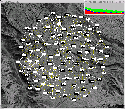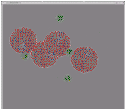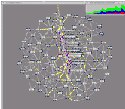
This recording shows an actual deployment of a 25 node network performing its surveillance mission. The surveillance mission requires the smooth interaction of all parts of the sensor protocol suite. Tracking is provided by the collaborative tracker. Information handling is provided by the distributed data cache. Medium access is provided by the sas medium access protocol.
The nodes were hastily deployed along a couple of intersecting paths by two people in about 15 minutes (average 2 minutes/node) at a spacing of about 15-20m. Deployment consists of inserting 2 AA batteries, closing the case, and setting the node in place. No configuration information is supplied to the node.
The nodes are shown as the small black dots with white labels at the locations reported by the nodes themselves. Individual detections are shown as the large red circles centered on the detecting node. The target track is shown as the small colored circles and velocity vectors. As the track is extended, subsequent track points are connected with a thin line.
This short snippet of data (about 2 minutes) is played at about 2x real time. The data is extracted from node afba and recorded on a laptop computer in real time. In normal operation, only valid tracks are extracted to provide intrusion alerts to the network users. Node locations and detections are not required for operation and are normally not extracted in order to conserve energy. The intruder enters the sensor field from the north and travels south at a normal walking pace. The intruder is correctly detected and tracked in real time by the sensor network.
The careful observer may notice that the network initially forms 2 tracks (green and purple). After a few updates the tracks are merged and only 1 track continues. The observer may also notice that part way through the experiment, node ae8f inexplicably reports a change in its location and subsequently reports a detection at the false location. The cooperative tracker correctly rejects this false information as it is inconsistent with the other data and instead tracks the target through a large gap in the sensor field.
False, incorrect, and missing data are common problems when using low-power sensor nodes--cooperative processing in the network can resolve problems with poor sensor data to yield accurate and useful composite results.
 Network Formation |
 Busy Network |
 Quiet Network |
 Tracking |